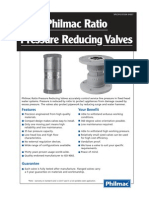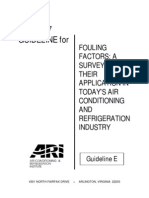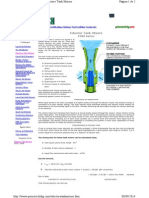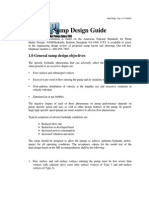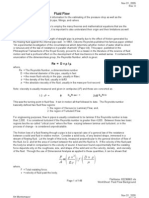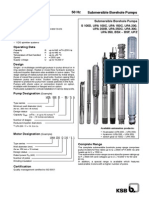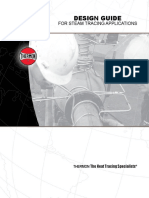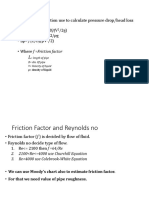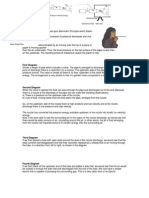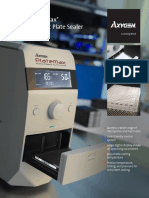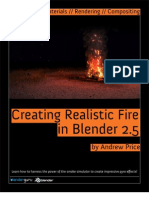Jet Mixing
Jet Mixing
Uploaded by
Salman SheikhCopyright:
Available Formats
Jet Mixing
Jet Mixing
Uploaded by
Salman SheikhOriginal Description:
Copyright
Available Formats
Share this document
Did you find this document useful?
Is this content inappropriate?
Copyright:
Available Formats
Jet Mixing
Jet Mixing
Uploaded by
Salman SheikhCopyright:
Available Formats
Jet mixing
Jet mixing is very turbulent mixing technology. It is the most efficient method to mix fluids while minimizing the horsepower required for mixing. Jet mixing is usually done by jet nozzles which are submerged in a vessel or a tank. More than two jets may be used for mixing. Jet mixing is the phenomena to intermingle the solute in solvent to make the desired product. Jet mixer is used for this purpose to entrain the fluid in solvent. Jet mixing is a very effective way to distribute mixing energy while minimizing power input in large diameter reactors. It is an efficient way to control i.e.: mixed, suspend, blend, and generate flow or chemical reaction. The superior performance of jet mixers are due to the following:
The high velocity liquid stream creates a negative pressure in the mixing chamber inducing additional liquid flow through the suction inlets located circumferentially around the outer mixing jet. The transfer of horizontal momentum from the high velocity stream to the surrounding liquid entrains additional bulk flow. The thrust imparted to the bulk liquid creates a small head gain which produces a horizontal bulk fluid velocity.
Principle: The high velocity fluid from jet enters into the stagnant fluid which is maintained in the vessel. The velocity of fluid remains constant and uniform as long as it remains in core which disappears after certain length from nozzle. As the fluid from jet moves its velocity decreases which is accompanied by increase in pressure according to Bernoullis equation.
The velocity decreases and pressure increases as a result the fluid is accelerated, blended and absorbed into the stagnant fluid causing efficient mixing. High shear stresses of jet fluid with stagnant fluid tear off eddies at the boundary, causing turbulent which result in efficient mixing.
Working: Jet mixing employs a special dual nozzle assembly with entrainment ports. Tank liquid is pumped through a liquid line and then through the inner nozzle. High velocity is created by the inner nozzle forming a jet plume. This jet plume pulls tank liquid through the entrainment port and then discharges the liquid through the outer nozzle. Transfer of the high velocity stream to the surrounding liquid entrains additional flow increasing the pumping rate by as much as ten times the pumping capacity.
There are no moving parts within the jet mixing nozzle with several nozzles typically installed along a header system or radially around a central mounted cluster. Several different nozzle sizes are available depending on the particular application and type of mixing energy desired Each jet nozzle entrains a large volume of liquid, using a small amount of pumped fluid. This innovative system produces extremely high mixing rates and strong movement using very little energy.
Jet mixing has many advantages: o Long Life o Highly Efficient o Low Capital Cost o Reduced Installation Cost o No In-Tank Maintenance Items o Superior Corrosion and Abrasion Resistant o Materials of Construction
Significance and Applications of jet mixing: It is mostly used when high turbulence and local shear stresses are to be achieved. So it will take less time to from homogenous mixture. It is normally used for liquids and slurries with viscosities less than 1000cP. Mainly use for liquid blending e.g. neutralization and extraction. NEUTRALIZATION: Jet mixers are used for pH control in neutralization tanks. A typical holding time in neutralization tanks is 30 minutes to one hour. Typical mixing intensity for pH neutralization tanks is 100 BHP per million gallons. SOLIDS SUSPENSION: Jet mixers are used for suspending solids in process tanks. Typical applications include mixing sludge tanks, phosphoric acid storage tanks, and corn steep tanks.
EQUALIZATION BASINS: Jet mixers have been used for mixing large equalization basins where the liquid level can vary from 3 to 30 ft. The jet mixers are installed near the bottom of the tank such that the tanks can be mixed at low and high liquid level conditions. Typical HP intensity for mixing equalization basins is 40 to 80 BHP per million gallons. LIQUID/LIQUID BLENDING: Liquid blending is a mixing operation in which two or more miscible liquids are mixed together with the help of jet mixer until a certain degree of homogeneity is achieved. Liquid blending is a very important part of the consumer product industry. Perfume: In the manufacturing of perfume, blending is required to dilute the concentrated perfume oils by dissolving them in ethanol through jet mixer. Toothpaste: Blending is also required in the production of toothpaste. For example: Adding the flavoring agents through jet mixer the contents are mixed under vacuum to produce the desired smoothness and homogeneity in the final product. Flash Mixing: Jet mixers are used for high intensity flash mixing tanks. These mixers are used to contact the chemical directly through the mixing nozzles. Typical holding time in flash mixing tanks is 30 seconds to 2 minutes.
Aeration by mixing
JET AERATION HISTORY: Jet aerators or educators have been utilized for gas/liquid contacting and mixing for over hundred years. Over the past decades, jet aeration has become widely accepted, and increasingly popular in waste water treatment technology. Since 2006 the KLa Systems aerators we are implementing, are provided with a Slot Injector aeration system. This unique, innovative, high efficiency jet aeration system has been used worldwide in various industrial areas such as food and beverage, pulp and paper, chemical processing, and landfill treatment operations. Operating Principals of traditional jet aerators: Submerged jet aeration intermixes air with a motive liquid and injects the stream into the waste water. The aerator itself consists of two jet nozzles. The motive liquid - recirculated mixed liquor - is discharged from an inner nozzle into an outer mixing nozzle, within which compressed atmospheric air is introduced and sheared into tiny bubbles which are entrained in the motive liquid stream.
As the stream is discharged into the surrounding mixed liquor, it forms a highly turbulent jet plume. The plume entrains the surrounding mixed liquor and brings it into contact with the tiny air bubbles. The
Resultant oxygen transfer rate is extremely high. This efficiency is due to the high air/waste interface area created by the minuscule bubbles, the turbulence within the jet plume, and the extended bubble residence time. Slot Injector Aeration Technology: Introduced in 1979 by Bayer AG, the Slot Injector aerator is similar to a modern jet aerator, but uses a slot-shaped configuration to achieve higher efficiencies. The slot-shaped nozzle and mixing chamber provide a greater shear surface for mass transfer than a circular jet opening of identical area.
The unique shape of the Slot Injector results in a high percentage of gas dissolution and superior mass transfer rates. Complete System Solutions: A typical Slot Injector system consists of the Slot Injector aerators, in -basin piping system, back-flush system, liquid recirculation pumps, and air blowers. The pumps are either end suction centrifugal, submersible, or self-priming. Low pressure air is delivered by positive displacement blowers, screw compressors, multi-stage centrifugal blowers, or high speed turbo blowers. Other available components of the Slot Injector system included with the out-of-basin air and liquid piping system consists of stainless steel pipe, isolation valves, expansion bellows, supports, and pressure gauges. Additional scope of supply is available upon request. Back-Flush System: Water Environment Research Foundation studies show that fine-pore diffusers have reduced oxygen transfer performance and increased pressure requirements over time due to clogging, and the biggest drop-off is in the first 24 months of operation. It is not uncommon for these types of aeration systems to require frequent cleaning and replacement within the first 5 years of operation. This is not the case with Slot Injector systems due to much larger openings and self-cleaning capabilities, which allows for cleaning out the injectors without the need to drain or enter the basin. Back-flushing the Slot Injector system is conducted essentially with an airlift pump that reverses the flow through the inner injector nozzle resulting in a powerful air-liquid stream that clears trash and debris from the system. Slot Injector aeration systems are known for long-term, reliable operation.
Overall advantages of Jet aeration systems in wastewater treatment applications: Low Installed Cost Low Energy Cost Low Maintenance Cost High oxygen transfer efficiency Long-term and stable efficiency - Proven 20+ Years Design Life Superior mixing capacities, without extra mixing and without extra oxygen supply (anoxic periods) No aerosols No pre-cooling of the aerated liquid Frost insensitive Low foam formation sensitivity No moving parts in the aeration basins Very suitable for use in deep aeration basins Obstruction insensitive Reduced Off-gas Volume Superior Process Performance
You might also like
- DCD 6 - Plate Design PDFDocument53 pagesDCD 6 - Plate Design PDFChristopher RileyNo ratings yet
- The Layout of Fluid Mechanics and Hydraulic Machinery LabDocument4 pagesThe Layout of Fluid Mechanics and Hydraulic Machinery LabAhmad RazaNo ratings yet
- API Standard 2000 - Venting Atmospheric and Low-Pressure Storage Tanks: Nonrefrigerated and RefrigeratedDocument5 pagesAPI Standard 2000 - Venting Atmospheric and Low-Pressure Storage Tanks: Nonrefrigerated and RefrigeratedNicolas CardonaNo ratings yet
- Unified Model For Gas - Liquid Pipe Flow Via Slug Dynamics - Part 1 - Model DevelopmentDocument8 pagesUnified Model For Gas - Liquid Pipe Flow Via Slug Dynamics - Part 1 - Model DevelopmentleofrazaoNo ratings yet
- Unit 01-08 - 3rd Ed. RDS (IADC-PETEX) - Circulating Systems PDFDocument59 pagesUnit 01-08 - 3rd Ed. RDS (IADC-PETEX) - Circulating Systems PDFRoyNo ratings yet
- Sae As 1933-1998 (R2004)Document6 pagesSae As 1933-1998 (R2004)anon_450417372No ratings yet
- Ratio Pressure Reducing ValvesDocument4 pagesRatio Pressure Reducing Valveskanem1No ratings yet
- Tank Rapid MixDocument5 pagesTank Rapid Mixvicdejo100% (1)
- SULZER Water MixerDocument12 pagesSULZER Water MixerAlfonso José García LagunaNo ratings yet
- Gas Jet Pump Paper Oct03 Ipa03 e 059Document11 pagesGas Jet Pump Paper Oct03 Ipa03 e 059kglorstadNo ratings yet
- ARI Guide Line 97 For Fouling Factor ApplicationsDocument8 pagesARI Guide Line 97 For Fouling Factor ApplicationsNour Saad EdweekNo ratings yet
- Sizing of Two Phase Vertical SeparatorDocument3 pagesSizing of Two Phase Vertical SeparatorJatin RamboNo ratings yet
- Applying NPSH To Metering PumpsDocument3 pagesApplying NPSH To Metering PumpsJoce88888100% (1)
- Pressure Drop in PipelineDocument13 pagesPressure Drop in PipelineNilambar BarihaNo ratings yet
- Friction Loss For Pipe SizingDocument7 pagesFriction Loss For Pipe SizingHaresh JoganiNo ratings yet
- Mixing Time Jet MixerDocument9 pagesMixing Time Jet MixerLTE002No ratings yet
- Static Liquid Holdup in Packed Beds of Spherical ParticlesDocument4 pagesStatic Liquid Holdup in Packed Beds of Spherical ParticlesaegosmithNo ratings yet
- Tank Jet MixersDocument2 pagesTank Jet MixersImtinan MohsinNo ratings yet
- Process MaterialDocument184 pagesProcess Materialpramod11engNo ratings yet
- Pipe Contraction Pressure LossDocument8 pagesPipe Contraction Pressure LossblumunchieNo ratings yet
- Edutor Tank MixerDocument2 pagesEdutor Tank MixerLeandro BuosiNo ratings yet
- Tank EductorDocument3 pagesTank Eductorkonainglincho001No ratings yet
- 3 Phase SeparatorDocument3 pages3 Phase SeparatorjgkrishnanNo ratings yet
- Sump Design GuidanceDocument8 pagesSump Design GuidanceHuget StNo ratings yet
- Surge CalculationsDocument21 pagesSurge CalculationsSri DharNo ratings yet
- Art S Fluid FlowDocument148 pagesArt S Fluid Flowlkjasdf8879100% (1)
- Structured PackingDocument8 pagesStructured PackingUsama IqbalNo ratings yet
- Koya University Faculty of Engineering Chemical Engineering DepDocument10 pagesKoya University Faculty of Engineering Chemical Engineering Depahmed tobaNo ratings yet
- Column Internals: 1. Liquid DistributorDocument2 pagesColumn Internals: 1. Liquid Distributornaved ahmedNo ratings yet
- Witte - Liquid-Gas Ejektor Design PDFDocument114 pagesWitte - Liquid-Gas Ejektor Design PDFOssian89No ratings yet
- Pulsation Bottle SizingDocument2 pagesPulsation Bottle SizingEnrique CaroNo ratings yet
- Gas Pipeline Hydraulic Analysis CalculationDocument10 pagesGas Pipeline Hydraulic Analysis Calculationbalakrishna100% (3)
- Comparison of Two FEA Models For Calculating Stresses in Shell-And-tube Heat ExchangerDocument5 pagesComparison of Two FEA Models For Calculating Stresses in Shell-And-tube Heat ExchangerDevang DesaiNo ratings yet
- PED Ch1Document17 pagesPED Ch1dpatel 2310100% (1)
- Tech Guidance Storage TankDocument17 pagesTech Guidance Storage TankMichael SandersNo ratings yet
- Breather ValveDocument3 pagesBreather ValvevikasozaNo ratings yet
- AODD Pumps in Chemical ProcessesDocument7 pagesAODD Pumps in Chemical ProcessesAlexNo ratings yet
- A Process Design EngineerDocument10 pagesA Process Design EngineerjokishNo ratings yet
- What Is Process Flow DiagramDocument6 pagesWhat Is Process Flow DiagramDanh DothanhNo ratings yet
- An Explicit Equation For Friction Factor in PipeDocument2 pagesAn Explicit Equation For Friction Factor in PipeRiddhesh PatelNo ratings yet
- Solving Liquid Hammer Problems Using Pipenet Vision and Caesar IIDocument6 pagesSolving Liquid Hammer Problems Using Pipenet Vision and Caesar IIDino Dino100% (1)
- Velocity and Pressure Drop in PipesDocument5 pagesVelocity and Pressure Drop in PipesManojkumar ThilagamNo ratings yet
- Vertical Separator SizingDocument2 pagesVertical Separator SizingRAJIV_332693187No ratings yet
- Liquid Seal Water Seal DrumDocument6 pagesLiquid Seal Water Seal Drumhk168No ratings yet
- Surge Tank ModelDocument10 pagesSurge Tank Modelkapil100% (1)
- Reciprocating Pump PratishthaDocument13 pagesReciprocating Pump Pratishthamike rosaNo ratings yet
- Static MixersDocument12 pagesStatic MixersCal100% (2)
- Submersible Borehole Pumps - 50 HZDocument118 pagesSubmersible Borehole Pumps - 50 HZanirbanpwd76No ratings yet
- Centrifugal Pumps - Minimum FlowDocument2 pagesCentrifugal Pumps - Minimum FlowTrịnh Đức Hạnh100% (1)
- Suction BellmouthsDocument4 pagesSuction BellmouthsAnonymous Kr13NEB100% (1)
- TSP0013 Steam Tracing DesignDocument23 pagesTSP0013 Steam Tracing DesignFabio TemporiniNo ratings yet
- Aqua Ammonia TablesDocument11 pagesAqua Ammonia TablesDoug LambNo ratings yet
- Two-Phase Flow (Gas-Flow) Line SizingDocument24 pagesTwo-Phase Flow (Gas-Flow) Line SizingvictorvikramNo ratings yet
- Evaluate Filtration Feasibility in ANFDDocument3 pagesEvaluate Filtration Feasibility in ANFDpratikNo ratings yet
- Liquid Jet Mixers: Circulate LiquidsDocument2 pagesLiquid Jet Mixers: Circulate LiquidsaravindNo ratings yet
- HydrocycloneDocument11 pagesHydrocycloneneeraj514No ratings yet
- Line Sizing With Example PDFDocument15 pagesLine Sizing With Example PDFAmol100% (1)
- Clear Water From Industrial Waste Water: 80m3/hr, 80mDocument9 pagesClear Water From Industrial Waste Water: 80m3/hr, 80mSameera RanasingheNo ratings yet
- VAcuum Systems ComparisionDocument8 pagesVAcuum Systems ComparisionSANTOSHNo ratings yet
- Unit Operation II TaskDocument14 pagesUnit Operation II TaskDilaFirizqinaNo ratings yet
- Ejectors and EductorsDocument9 pagesEjectors and EductorsGanesan BalrajNo ratings yet
- Class A Foam Mixing and Application EquipmentDocument5 pagesClass A Foam Mixing and Application EquipmentSureen NarangNo ratings yet
- Simulation Final ProjectDocument10 pagesSimulation Final ProjectSalman SheikhNo ratings yet
- Evaluation Form FOR Interviews: Statement 5 4 3 2 1 Interpersonal SkillsDocument1 pageEvaluation Form FOR Interviews: Statement 5 4 3 2 1 Interpersonal SkillsSalman SheikhNo ratings yet
- An Overview of Industrial Processes For The Production of Olefins - C4 HydrocarbonsDocument12 pagesAn Overview of Industrial Processes For The Production of Olefins - C4 HydrocarbonsSalman SheikhNo ratings yet
- Sulphuric Acid ProductionDocument38 pagesSulphuric Acid ProductionSalman Sheikh50% (2)
- Classical Mechanics With MATLAB Applications Javier E - HasbunDocument5 pagesClassical Mechanics With MATLAB Applications Javier E - HasbunAdam A. KhanNo ratings yet
- 2014 CE - Science and Technology Form II Paper IDocument6 pages2014 CE - Science and Technology Form II Paper IIAN KELLYNo ratings yet
- LH - Lesson 1.1 - 1.2Document3 pagesLH - Lesson 1.1 - 1.2joel gatanNo ratings yet
- CH 08 09 Prac Test-BondingDocument24 pagesCH 08 09 Prac Test-BondingJuventie PrimastutiNo ratings yet
- 2.PFD & PQCS-18293-KVT-9000Document3 pages2.PFD & PQCS-18293-KVT-9000RS MANIKANDANNo ratings yet
- Project For Using Different Sizes of Coarse Aggregate For Concrete StrengthDocument18 pagesProject For Using Different Sizes of Coarse Aggregate For Concrete StrengthZohaib Siapad100% (7)
- Acidos Organicos Mecanismo SiiiiiiiiiiiDocument58 pagesAcidos Organicos Mecanismo SiiiiiiiiiiiEunice VegaNo ratings yet
- Standard Operating Procedures For SO2 MonitoringDocument54 pagesStandard Operating Procedures For SO2 MonitoringFredi Cari CarreraNo ratings yet
- Axygen Platemax Semi-Automatic Plate Sealer: A Corning BrandDocument4 pagesAxygen Platemax Semi-Automatic Plate Sealer: A Corning BrandjaredNo ratings yet
- Carbonic Acid Production in H O:Co Ices: UV Photolysis vs. Proton BombardmentDocument8 pagesCarbonic Acid Production in H O:Co Ices: UV Photolysis vs. Proton BombardmentHidayat PurwantoNo ratings yet
- Identification of Pitfalls in PVT Gas Condensate Modeling Using Modified Black-Oil FormulationsDocument13 pagesIdentification of Pitfalls in PVT Gas Condensate Modeling Using Modified Black-Oil FormulationsChávez Ibarra Sergio Kevin100% (1)
- Career Point: Pre Foundation DivisonDocument8 pagesCareer Point: Pre Foundation DivisonMeenakshiSundareshNo ratings yet
- Creating Realistic Fire in Blender 2.5Document12 pagesCreating Realistic Fire in Blender 2.5mixer5056100% (1)
- BS EN 1302 - 1999 Chemicals Used For Treatment of Water Intended For Human Consumption. Aluminium-Based Coagulants. Analytical Methods.Document46 pagesBS EN 1302 - 1999 Chemicals Used For Treatment of Water Intended For Human Consumption. Aluminium-Based Coagulants. Analytical Methods.Денис100% (1)
- Aetherometric Theory of Synchronicity - Encyclopedia NomadicaDocument2 pagesAetherometric Theory of Synchronicity - Encyclopedia NomadicaMycoLogist4LifeNo ratings yet
- Water Density - EggDocument5 pagesWater Density - EggMagi ThiranNo ratings yet
- Module 3Document107 pagesModule 3Anshu MalikNo ratings yet
- Names and Formulas of InorganicDocument24 pagesNames and Formulas of InorganicMae SocialNo ratings yet
- Dimond Wheel BrochureDocument7 pagesDimond Wheel BrochurejogibhavinNo ratings yet
- Ionization Chambers IIDocument60 pagesIonization Chambers IIKamran AhmadNo ratings yet
- Fulaz - Utg-016Document1 pageFulaz - Utg-016Abhishek DevarajNo ratings yet
- ch1 PDFDocument99 pagesch1 PDFsamyNo ratings yet
- Cat CSVDocument36 pagesCat CSVaqhammamNo ratings yet
- Density Functionals For Couiomb Systems: Departments New Jersey 08544, U.S.ADocument35 pagesDensity Functionals For Couiomb Systems: Departments New Jersey 08544, U.S.ARamon FerreiraNo ratings yet
- Prafulla Chandra Roy BiographyDocument4 pagesPrafulla Chandra Roy Biographytarakkarmakar22No ratings yet
- Investigations of The Hydration Expansion Characteristics of Portland CementsDocument181 pagesInvestigations of The Hydration Expansion Characteristics of Portland CementsElZeroMJ100% (1)
- Turbomachinery Aerodynamics Prof. Bhaskar Roy Prof. A M Pradeep Department of Aerospace Engineering Indian Institute of Technology, BombayDocument25 pagesTurbomachinery Aerodynamics Prof. Bhaskar Roy Prof. A M Pradeep Department of Aerospace Engineering Indian Institute of Technology, BombaySpeculeNo ratings yet
- INTERTEK Racking Shear Test Report FinalDocument63 pagesINTERTEK Racking Shear Test Report FinalrycproyectistaNo ratings yet






